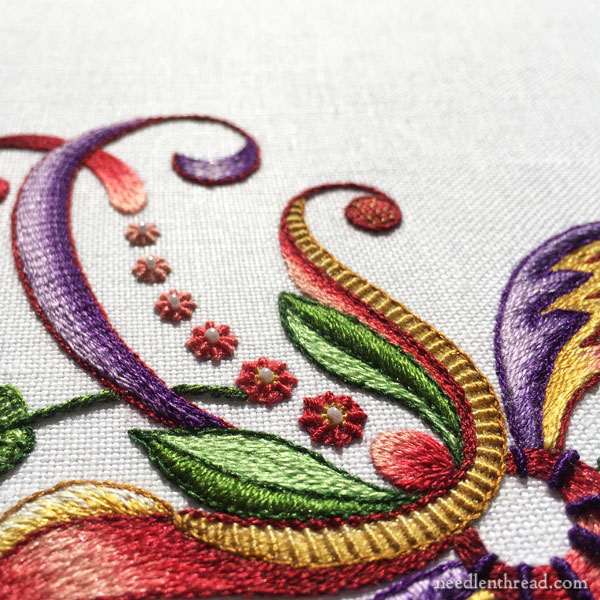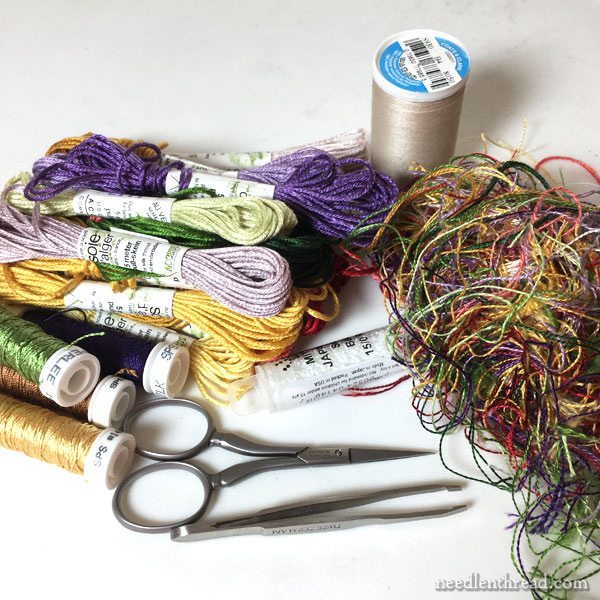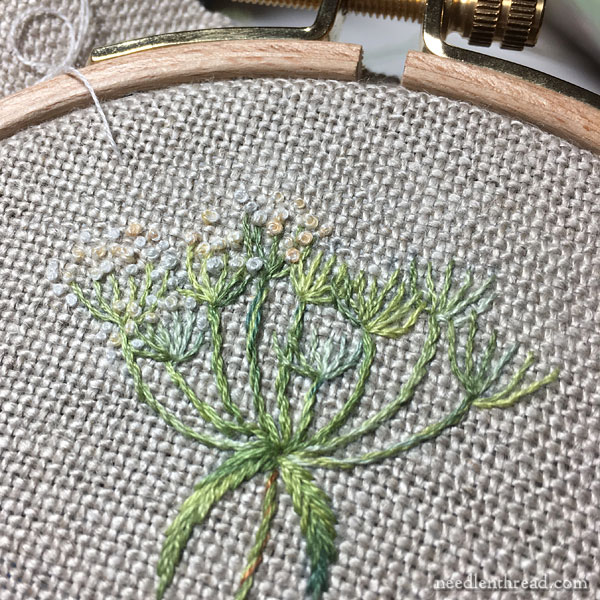This week, I finished an embroidery project.
Once upon a time, I disliked coming to the end of a project. As I approached the end, I’d start to feel a little sad. I called it the End-of-Project Blues. It’s that time when you realize that the enjoyment you’ve had in stitching a project and seeing it come to life is about to end.
And it’s that time when you realize that you’ve got to go through the whole process of deciding and setting up another project before you can settle into the bliss of having something fun to stitch.
These days, though, I have so many projects in the wings planned out for Needle ‘n Thread, that I don’t have a chance to feel blue at all! There’s that brief elation of finishing a project, pleased that it came out at least somewhat similar to what I envisioned, rapidly followed by The Next Thing.
There’s always a method in my project line-up when I’m stitching things in relatively quick succession, though. It’s not just a random grab-whatever-and-get-going approach. I put a little bit of thought behind the order of choosing projects, for very specific reasons.
Come along, and I’ll tell you my thought processes…

So, the larger project that I finished this week – you can see some sneak peeks above and below – is embroidered in a nice array of Au Ver a Soie silk threads, primarily Soie d’Alger with a bit of Soie Perlee for good measure. Besides a few little bead accents, the whole project is silk, and it’s pretty solidly stitched.
It’s worked on white linen – Alba Maxima, by Legacy Linens, which is an approximately 40-thread-count closely woven, beautiful linen suitable for any type of surface embroidery. I backed it with cotton, to give some extra support, since I knew I’d be working some dense filling areas.
This is the type of project I set up on stretcher bars (I use Evertite stretcher bars) or on a slate frame. In this case, it was on stretcher bars – they’re faster to set up and they don’t take up as much space.

The double layer of fabric, stretched taut, requires some intense finger work. It’s more difficult to pass a needle through a double layer of fabric stretched taut on a frame than it is to pass a needle through, say, a cotton flour sack towel.
I use a needlework stand to hold my frame while I stitch, and I work the whole thing with both hands, making use of a laying tool quite frequently.
With several shaded areas that I was working through for the first time, and with several stitch combinations that I was making decisions on as I went, it was the type of project that required me to sit up straight and pay attention. It’s not really a lounge-about-on-the-sofa sort of project.
It was also the type of project that involved unstitching quite frequently – taking out little areas that didn’t work as well as I thought they would, changing my mind on colors or shades. So, persnickety picking with tweezers and cleaning up the resulting mess then starting over in that area was just part of the journey. I don’t mind picking out, but it does add a bit to the work load!

When I finally finished the project and had it all cleaned up, I was more than ready to move on, with eagerness, to the next bit in my project line-up!
When planning out my stitching for the next couple months, I arranged my projects in a specific order, based on the principle that all work and no play makes anyone – and any pursuit – a bit too dull.
So my next several projects are a lot less formal. They’re definitely lounge-about-on-the-sofa or pack-in-a-bag-and-take-anywhere sort of projects.
They’re on different types of fabric, from looser or softer linen to cotton.
They’re small – they fit in 4″ – 6″ hoops.

They don’t require a vast amount of thread.
They don’t require any deep decisions about what stitches to use.
The needles are larger and more comfortable to hold.
The designs, though not large, are easy to see. They don’t require as much accuracy when stitching them.
And if I make a small mistake, I can usually turn it into a happy accident and incorporate it into the design.
In short, they’re pretty casual.
So, when planning my projects out, I always make sure I have a good mix of project types in my line-up. If I have “formal” projects in the plan, I always make sure that, between the heavyweight stuff, some casual projects that are less intense are awaiting my pleasure!
The Benefits of Mixing Things Up
Having a mix of project types to work on is beneficial in several ways:
1. When a more difficult project starts to drag, you can take a break and move to something light for a while. If you’re the type who must finish each project before starting a new one, then you’ll have a carrot to motivate you through the hard parts.
2. It’s nice to give your eyes, hands, shoulders, neck and back a break from intense stitching! Casual stitching projects do just that. They give you something to really unwind and relax with.
3. Mixing up the approach to projects keeps embroidery exciting and keeps the creative juices flowing!
More on Project Organization and Rotation
I wrote an article a while back on managing multiple embroidery projects at one time. If you’ve got several projects going and you’re having trouble keeping them straight or making progress, you can check it out! It might help you!
What About You?
Do you plan ahead on your stitching projects, so that you’re giving yourself a break from heavy-duty projects? Or do you generally stitch the same types of projects all the time? How do you plan out your projects, if you want to accomplish multiple projects in a certain period of time? Any time or planning tips you want to share? Feel free to have your say below! I look forward to hearing from you!
Connect with Stitchers & Get Inspired!
If you happen to be on Facebook and you want to connect with a bunch of very enthusiastic stitchers, to get inspired or even to help “pay it forward” with your own stitching knowledge and skills, by helping newbies get started with embroidery, why not join the Needle ‘n Thread Community on Facebook?
The Needle ‘n Thread community on Facebook is a closed group, where folks can share their stitching projects and progress, post photos, discuss techniques, ask questions, get good advice from other stitchers, and find plenty of inspiration!
Joining up is simple – just request to join and fill out the answers to the three questions. (The questions help me keep spammers out of the group.)
I hope to see you over there!